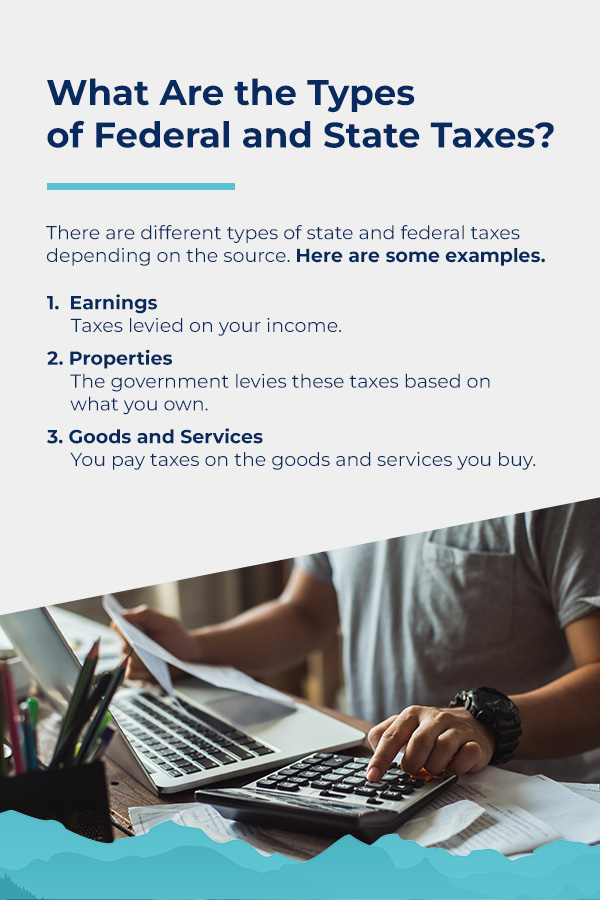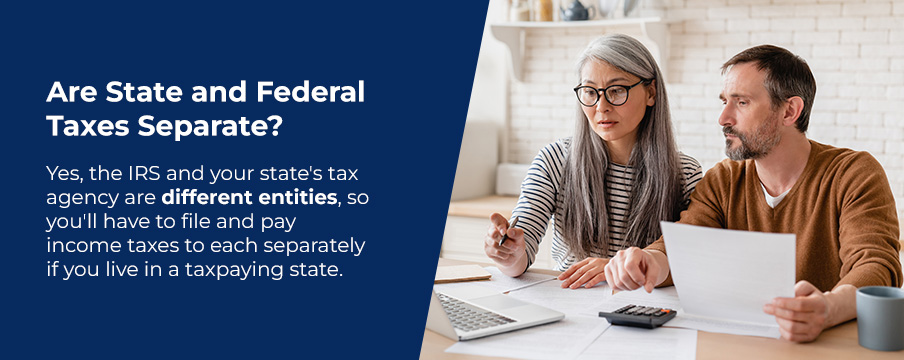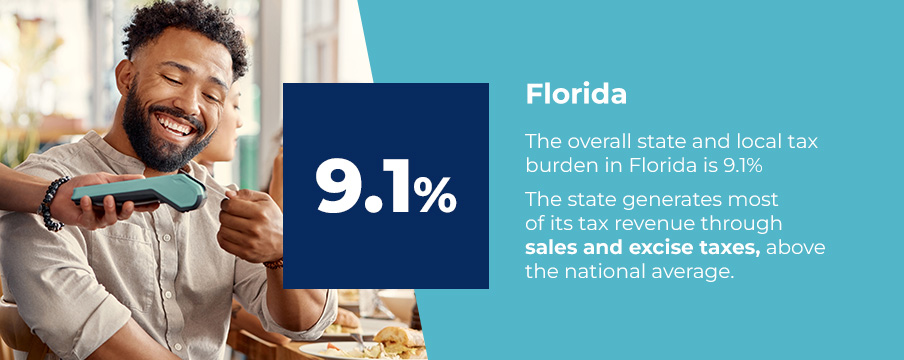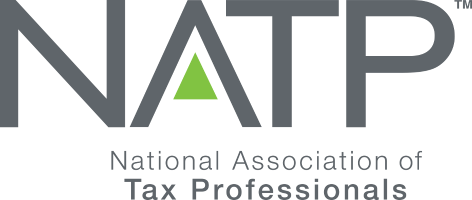While all taxes are mandatory payments that fund various government services, the taxes you pay at the federal and state levels vary in several ways, and the processes for preparing and filing them also differ. In this guide, we’ll detail all these distinctions and provide valuable tips for reducing your federal and state tax liabilities.
Federal vs. State Income Tax
The primary difference between federal tax vs. state tax is who collects the money. While U.S. taxpayers send federal income tax returns to the Internal Revenue Service, each state also has a separate taxing authority. For example, in Colorado, the Taxation Division of the Department of Revenue administers and enforces the state’s income, sales and property taxes.
Ultimately, federal and state taxes have the same purpose, but on different levels. For example, your federal taxes fund things like the military, the president and Congress. On the other hand, your state taxes pay for local roads and the governor’s salary.
If you live in a state that collects state income tax, you’ve probably noticed state taxes withheld from your paychecks alongside federal income taxes. Though the filing deadlines and procedures can differ, you’ll typically file state and federal income taxes simultaneously to report all your income, credits and claim deductions.
What Are the Types of Federal and State Taxes?
There are different types of state and federal taxes depending on the source. Here are some examples.

1. Earnings
Taxes levied on your income include the following.
- Personal income tax: You pay taxes on salaries, wages, investments and other income sources. The federal government creates tax brackets using a progressive system. Some states also employ this same tax computation system, but others prefer using a flat rate.
- Corporate income tax: Federal and state governments levy corporate income taxes on business profits. Businesses in the U.S. may either be C corporations or S corporations. C corporations pay corporate income taxes, but S corporations pass their incomes through the owners’ or shareholders’ tax returns and pay personal income taxes.
- Payroll tax: The government levies taxes on your paycheck to finance social insurance programs. Some of the payroll tax funds Social Security, while the other part funds Medicare. Employers directly remit half of their payroll taxes, withholding the other half from the employee’s salary or wages.
- Estate tax: When you pass away and bequeath your assets to someone else, estate taxes are due on the property. Though this is generally a federal tax, some states impose something similar but call it other names, like inheritance taxes and death taxes.
- Capital gains tax: Capital gains taxes are on profits from selling assets, such as real estate, bond transactions and stocks. The tax rate depends on your income — the more you earn, the higher your rate.
2. Properties
The government levies these taxes based on what you own and include the following.
- Property tax: Property taxes depend on the value of real or personal assets. Local governments usually charge them recurringly. Homeowners may pay property taxes as part of their monthly mortgage or as a separate payment once or twice annually.
- Personal property tax: You pay personal property taxes on mobile assets, including vehicles, boats and mobile homes. The tax is part of the annual licensing or registration fee you pay each year.
- Real estate tax: Real estate taxes are a percentage of the property’s appraised value.
3. Goods and Services
You pay taxes on the goods and services you buy, including the following.
- Sales tax: Sales taxes on retail purchases vary from state to state and are generally percentage-based, depending on the item you buy. Local and state governments typically assess sales taxes.
- Excise tax: Unlike price-driven sales taxes, excise taxes relate to the quantity of items you buy. Federal, state or local agencies may impose excise taxes on importers, retailers, manufacturers and consumers.
- User fees: User fees for various services include rental cars, airline tickets, utilities, toll roads, licenses, hotel rooms and financial transactions.
- Luxury tax: Luxury taxes on high-cost items include expensive jewelry, extravagant vehicles and private jets.
- Sin tax: You’ll pay “sin” taxes when buying products like alcohol and cigarettes.
How Do Federal and State Income Taxes Work?
The IRS oversees federal income taxes using the progressive system of marginal tax rates and brackets. In other words, you pay more taxes as your income increases. State income taxes use some federal tax principles when computing state income taxes. However, the tax rates, filing schedules, available deductions and credits may vary.
Like the IRS, some states use the progressive tax system with tax brackets and marginal rates, while others apply a flat rate to all taxable income. For example, Colorado residents pay a flat income tax of 4.4%.
What Are Federal and State Tax Brackets?
A tax bracket is the range of income taxed at a given rate. Tax brackets typically differ depending on filing status and taxable income. At the federal level, the federal government divides taxable incomes into chunks and allocates a corresponding rate to each. These thresholds may change annually to reflect the inflation rate. States using the progressive system may have different tax brackets. For example, Colorado uses a flat income tax rate of 4.4% on taxable income.
Are State and Federal Taxes Separate?

Yes, the IRS and your state’s tax agency are different entities, so you’ll have to file and pay income taxes to each separately if you live in a taxpaying state. While some of the information on your state and federal income taxes may be the same, other taxes, credits and deductions may apply, depending on where you live.
Also, though you may be filing two separate returns received and processed by two distinct government agencies, the e-filing system may link them if you use the same online tax service for both. Generally, you’ll need to complete your federal tax returns before paying state taxes.
How Do You File Federal Income Taxes?
You remit and report your federal taxes to the IRS through a series of forms created by the U.S. Department of the Treasury. Primary among them is Form 1040, which collects your information and income and tax benefit activities for the year. Form 1040 varies depending on your activities in the previous year.
You may attach or submit extra forms if you have further information to provide. For example, if you want to claim itemized deductions, you must submit Schedule A to support your return. You may need additional forms for many tax credits.
How Do You File State Income Taxes?
In most cases, you must complete your federal income tax returns before preparing and filing your state return. There are many ways to do this. The IRS offers free filing of federal and state tax returns for specific categories of taxpayers. You may also qualify for Volunteer Income Tax Assistance, but the requirements are stricter. Tax Counseling for the Elderly also offers free tax return preparation services for people 59 and older.
You can either prepare and file your state income tax returns electronically or mail the paper forms to the state agency. Each state has tax forms, which you can obtain on the state’s online portal or a third-party website. For example, in Colorado, you’ll need Form 104 to file individual income tax returns.
What Are the States With No Income Tax?
Currently, eight states do not levy income taxes. These are Alaska, Florida, Nevada, South Dakota, Tennessee, Texas, Washington and Wyoming. New Hampshire does not tax earned income, but will continue levying taxes on interest and dividends through 2027. Let’s look at each in detail.
1. Alaska
Alaska is one of the country’s tax-friendliest states. The state removed personal income taxes in 1980, instead taxing oil and gas production companies at higher rates. According to the Tax Foundation, Alaska has the lowest overall state and local tax burden, at 4.6%. However, the cost of living in Alaska is relatively high. Residents receive annual payments from the Alaska Permanent Fund Corporation, which was $3,284 in 2022.
2. Florida

The overall state and local tax burden in Florida is 9.1%. The state generates most of its tax revenue through sales and excise taxes, above the national average. Also, the cost of living is relatively high, with competitive housing and prices.
3. Nevada
Nevada has an overall state and local tax burden of 9.6%. The state generates most tax revenue through excise, sin and sales taxes. The hospitality and tourism industries, including hotels and gaming establishments, generate revenue. Nevada’s overall cost of living is high, but property taxes are generally low.
4. South Dakota
Though South Dakota has no income tax, it generates revenue from other forms of taxation, such as excise and sin taxes. The overall state and local tax burden is 8.4%. Property tax rates are relatively high.
5. Tennessee
Tennessee levies higher sales taxes on items like alcohol, beer and fuel. Even fantasy sports contests attract a levy of 6%. However, the state’s overall tax burden is low, standing at 7.6%. Tennessee is a more affordable place to live than many other states
6. Texas
The second largest state in the U.S. after Alaska, Texas has an overall state and local tax burden of 8.6%. Sales and property taxes can be high in some jurisdictions, but the state is affordable with a low cost of living.
7. Wyoming
The least populated state in the country, Wyoming, relies on sales, excise and property taxes for income generation. The cost of living and housing is slightly above average. However, the overall state and local tax burden is low at 7.5%.
8. Washington
People and corporations in Washington are exempt from state income taxes. However, businesses are subject to business and occupation taxes, retail sales and use taxes and personal property taxes. The overall state and local tax burden is 10.7%, with a higher-than-average cost of living.
9. New Hampshire
Technically, New Hampshire is not an income tax-free state — at least, not yet. The state still taxes interest and dividends on investment income at 5%, which will reduce annually until it completely phases out in 2027. The overall state and local tax burden is 9.6%.
When Do You Have to File More Than One State Tax Return?
You may need to file an income tax return in more than one state if you moved during the year or worked in two or more states. Things might get trickier if you live in one state and commute to another for work. If the two states have a reciprocal agreement, you may only have to file your income tax returns where you live. Also, some states have specific tax forms for full-time residents working in a reciprocal state.
How Do You Reduce Federal and State Taxes?
Here are tips on how to reduce your taxes.
1. Tax Deductions
The law allows taxpayers to reduce their taxable income in several ways. Here are some examples.
- Donating to charity: When you donate to a charitable course, you can write off the contributions by adding them to your itemized deductions. The same applies to cash gifts, non-cash donations and appreciated stocks. You may even include the mileage for transportation to do charity work or the expenses you incurred preparing meals for the charity.
- Working as self-employed: If you’re self-employed or doing side projects for extra cash, you may make several deductions. For example, you may deduct expenses related to the business, such as advertising, shipping, website fees, internet charges, business-related vehicle mileage and office supplies.
- Working at home: Taxpayers may claim deductions by declaring a portion of their home as an office.
2. Tax Credits
Tax credits are legislative incentives that allow taxpayers to reduce the amount of taxes they owe. For example, a taxpayer eligible for a child tax credit can directly apply the credit to their actual tax liability rather than the taxable income, as done in the case of deductions. There are many types of tax credits, including the Lifetime Learning Credit, American Opportunity Tax Credit and Earned Income Tax Credits.
3. Health Savings Accounts
You can set up a health savings account for specific health care costs. It enables you to spend your tax-free money on qualified medical expenses. Instead of using other income sources, you can rely on your HSA.
Contact BC Tax Now to Learn More
BC Tax is a renowned tax consultancy firm with over 21 years of experience providing tailored solutions to clients nationwide. Our team of tax professionals offers a free, no-obligation consultation. Do you want to learn more about federal and state taxes or need help preparing and filing your returns? Contact us now!

 1-800-548-4639
1-800-548-4639









